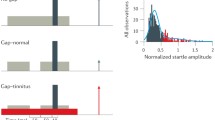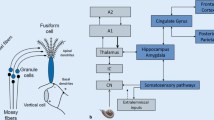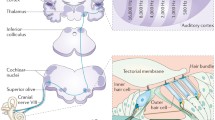Access this chapter
Tax calculation will be finalised at checkout
Purchases are for personal use only
Similar content being viewed by others
Abbreviations
- CNS:
-
Central nervous system
- MVD:
-
Microvascular decompression
References
Møller AR (2008) Neural Plasticity: For Good and Bad. Progress of Theoretical Physics Supplement No 173:48–65.
Henry JA, KC Dennis and MA Schechter (2005) General review of tinnitus: prevalence, mechanics, effects, and management. J Speech Lang Hear Res 48:1204–35.
Saunders JC (2007) The role of central nervous system plasticity in tinnitus. J Commun Disord 40:313–34.
Plewnia C, M Bartels and C Gerlof (2003) Transient suppression of tinnitus by transcranial magnetic stimulation. Ann Neurol 53:263–6.
Bartels H, MJ Staal and FW Albers (2007) Tinnitus and neural plasticity of the brain. Otol Neurotol 28:178–84.
Møller AR (2007) The role of neural plasticity, in Tinnitus: Pathophysiology and Treatment, Progress in Brain Research, B Langguth et al, Editors. Elsevier: Amsterdam. 37–45.
Møller AR (2006) Neural plasticity and disorders of the nervous system. Cambridge: Cambridge University Press.
Wall PD (1977) The presence of ineffective synapses and circumstances which unmask them. Phil Trans Royal Soc (Lond) 278:361–72.
Møller AR (2001) Symptoms and signs caused by neural plasticity. Neurol Res 23:565–72.
Møller AR, MB Møller and M Yokota (1992) Some forms of tinnitus may involve the extralemniscal auditory pathway. Laryngoscope 102:1165–71.
LeDoux JE (1992) Brain mechanisms of emotion and emotional learning. Curr Opin Neurobiol 2:191–7.
Møller AR (2003) Sensory Systems: Anatomy and Physiology. Amsterdam: Academic.
Lockwood A, R Salvi, M Coad et al (1998) The functional neuroanatomy of tinnitus. Evidence for limbic system links and neural plasticity. Neurology 50:114–20.
Tucker DA, SL Phillips, RA Ruth et al (2005) The effect of silence on tinnitus perception. Otolaryngol Head Neck Surg 132:20–4.
Caspary DM, TA Schatteman and LF Hughes (2005) Age-related changes in the inhibitory response properties of dorsal cochlear nucleus output neurons: role of inhibitory inputs. J Neurosci 25:10952–9.
Eggermont JJ (2005) Tinnitus: neurobiological substrates. Drug Discov Today 10:1283–90.
Baguley DM (2002) Mechanisms of tinnitus. Br Med Bull 63:195–212.
Smoorenburg GF (1993) Risk of noise-induced hearing loss following exposure to Chinese firecrackers. Audiology 32:333–43.
Humes LE, LM Joellenbeck and JS Durch (2005) Noise and Military Service: Implications for Hearing Loss and Tinnitus. 2005: Institute of Medicine of the National Academies.
Møller MB, AR Møller, PJ Jannetta et al (1993) Vascular decompression surgery for severe tinnitus: Selection criteria and results. Laryngoscope 103:421–7.
De Ridder D and P Van de Heyning (2007) The Darwinian plasticity hypothesis for tinnitus and pain, in Tinnitus: Pathophysiology and Treatment, Progress in Brain Research, B Langguth et al, Editors. Elsevier: Amsterdam. 55–60.
Author information
Authors and Affiliations
Corresponding author
Editor information
Editors and Affiliations
Rights and permissions
Copyright information
© 2011 Springer Science+Business Media, LLC
About this chapter
Cite this chapter
Møller, A.R. (2011). The Role of Neural Plasticity in Tinnitus. In: Møller, A.R., Langguth, B., De Ridder, D., Kleinjung, T. (eds) Textbook of Tinnitus. Springer, New York, NY. https://doi.org/10.1007/978-1-60761-145-5_12
Download citation
DOI: https://doi.org/10.1007/978-1-60761-145-5_12
Publisher Name: Springer, New York, NY
Print ISBN: 978-1-60761-144-8
Online ISBN: 978-1-60761-145-5
eBook Packages: MedicineMedicine (R0)




